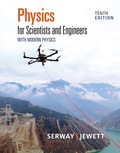
Physics for Scientists and Engineers with Modern Physics
10th Edition
ISBN: 9781337671729
Author: SERWAY
Publisher: Cengage
expand_more
expand_more
format_list_bulleted
Concept explainers
Question
Chapter 38, Problem 16P
(a)
To determine
The speed by which Kimmie is moving faster than Shannon.
(b)
To determine
The separation in spaces of two pulses.
Expert Solution & Answer
Want to see the full answer?
Check out a sample textbook solution
Students have asked these similar questions
Hi! I need help with these calculations for part i and part k for a physics Diffraction Lab. We used a slit width 0.4 mm to measure our pattern.
Examine the data and % error values in Data Table 3 where the angular displacement of the simple pendulum decreased but the mass of the pendulum bob and the length of the pendulum remained constant. Describe whether or not your data shows that the period of the pendulum depends on the angular displacement of the pendulum bob, to within a reasonable percent error.
In addition to the anyalysis of the graph, show mathematically that the slope of that line is 2π/√g . Using the slope of your line calculate the value of g and compare it to 9.8.
Chapter 38 Solutions
Physics for Scientists and Engineers with Modern Physics
Ch. 38.1 - Which observer in Figure 38.1 sees the balls...Ch. 38.1 - Prob. 38.2QQCh. 38.4 - Suppose the observer O on the train in Figure 38.6...Ch. 38.4 - Prob. 38.4QQCh. 38.4 - Prob. 38.5QQCh. 38.4 - You are observing a spacecraft moving away from...Ch. 38.6 - You are driving on a freeway at a relativistic...Ch. 38.8 - Prob. 38.8QQCh. 38 - In a laboratory frame of reference, an observer...Ch. 38 - Prob. 2P
Ch. 38 - Prob. 3PCh. 38 - Prob. 4PCh. 38 - Prob. 5PCh. 38 - An astronaut is traveling in a space vehicle...Ch. 38 - Prob. 7PCh. 38 - You have been hired as an expert witness for an...Ch. 38 - Prob. 9PCh. 38 - Prob. 10PCh. 38 - Prob. 11PCh. 38 - A cube of steel has a volume of 1.00 cm3 and mass...Ch. 38 - Review. In 1963, astronaut Gordon Cooper orbited...Ch. 38 - You have an assistantship with a math professor in...Ch. 38 - Prob. 15PCh. 38 - Prob. 16PCh. 38 - A moving rod is observed to have a length of =...Ch. 38 - Prob. 18PCh. 38 - Prob. 19PCh. 38 - You have been hired as an expert witness in the...Ch. 38 - Figure P38.21 shows a jet of material (at the...Ch. 38 - Prob. 22PCh. 38 - Prob. 23PCh. 38 - Prob. 24PCh. 38 - Prob. 25PCh. 38 - Prob. 26PCh. 38 - Prob. 27PCh. 38 - (a) Find the kinetic energy of a 78.0-kg...Ch. 38 - Prob. 29PCh. 38 - Prob. 30PCh. 38 - Prob. 31PCh. 38 - Prob. 32PCh. 38 - Prob. 33PCh. 38 - Prob. 34PCh. 38 - Prob. 35PCh. 38 - Prob. 36PCh. 38 - Prob. 37PCh. 38 - Prob. 38PCh. 38 - Prob. 39PCh. 38 - An unstable particle with mass m = 3.34 1027 kg...Ch. 38 - Prob. 41PCh. 38 - Prob. 42APCh. 38 - Prob. 43APCh. 38 - Prob. 44APCh. 38 - Prob. 45APCh. 38 - Prob. 46APCh. 38 - Prob. 47APCh. 38 - Prob. 48APCh. 38 - Prob. 49APCh. 38 - Prob. 50APCh. 38 - Prob. 51APCh. 38 - Prob. 52APCh. 38 - The creation and study of new and very massive...Ch. 38 - Prob. 54CPCh. 38 - Prob. 55CP
Knowledge Booster
Learn more about
Need a deep-dive on the concept behind this application? Look no further. Learn more about this topic, physics and related others by exploring similar questions and additional content below.Similar questions
- An object is placed 24.1 cm to the left of a diverging lens (f = -6.51 cm). A concave mirror (f= 14.8 cm) is placed 30.2 cm to the right of the lens to form an image of the first image formed by the lens. Find the final image distance, measured relative to the mirror. (b) Is the final image real or virtual? (c) Is the final image upright or inverted with respect to the original object?arrow_forwardConcept Simulation 26.4 provides the option of exploring the ray diagram that applies to this problem. The distance between an object and its image formed by a diverging lens is 5.90 cm. The focal length of the lens is -2.60 cm. Find (a) the image distance and (b) the object distance.arrow_forwardPls help ASAParrow_forward
arrow_back_ios
SEE MORE QUESTIONS
arrow_forward_ios
Recommended textbooks for you
 Principles of Physics: A Calculus-Based TextPhysicsISBN:9781133104261Author:Raymond A. Serway, John W. JewettPublisher:Cengage Learning
Principles of Physics: A Calculus-Based TextPhysicsISBN:9781133104261Author:Raymond A. Serway, John W. JewettPublisher:Cengage Learning University Physics Volume 3PhysicsISBN:9781938168185Author:William Moebs, Jeff SannyPublisher:OpenStax
University Physics Volume 3PhysicsISBN:9781938168185Author:William Moebs, Jeff SannyPublisher:OpenStax Modern PhysicsPhysicsISBN:9781111794378Author:Raymond A. Serway, Clement J. Moses, Curt A. MoyerPublisher:Cengage Learning
Modern PhysicsPhysicsISBN:9781111794378Author:Raymond A. Serway, Clement J. Moses, Curt A. MoyerPublisher:Cengage Learning Physics for Scientists and Engineers: Foundations...PhysicsISBN:9781133939146Author:Katz, Debora M.Publisher:Cengage Learning
Physics for Scientists and Engineers: Foundations...PhysicsISBN:9781133939146Author:Katz, Debora M.Publisher:Cengage Learning Physics for Scientists and Engineers, Technology ...PhysicsISBN:9781305116399Author:Raymond A. Serway, John W. JewettPublisher:Cengage Learning
Physics for Scientists and Engineers, Technology ...PhysicsISBN:9781305116399Author:Raymond A. Serway, John W. JewettPublisher:Cengage Learning College PhysicsPhysicsISBN:9781305952300Author:Raymond A. Serway, Chris VuillePublisher:Cengage Learning
College PhysicsPhysicsISBN:9781305952300Author:Raymond A. Serway, Chris VuillePublisher:Cengage Learning

Principles of Physics: A Calculus-Based Text
Physics
ISBN:9781133104261
Author:Raymond A. Serway, John W. Jewett
Publisher:Cengage Learning

University Physics Volume 3
Physics
ISBN:9781938168185
Author:William Moebs, Jeff Sanny
Publisher:OpenStax

Modern Physics
Physics
ISBN:9781111794378
Author:Raymond A. Serway, Clement J. Moses, Curt A. Moyer
Publisher:Cengage Learning

Physics for Scientists and Engineers: Foundations...
Physics
ISBN:9781133939146
Author:Katz, Debora M.
Publisher:Cengage Learning

Physics for Scientists and Engineers, Technology ...
Physics
ISBN:9781305116399
Author:Raymond A. Serway, John W. Jewett
Publisher:Cengage Learning

College Physics
Physics
ISBN:9781305952300
Author:Raymond A. Serway, Chris Vuille
Publisher:Cengage Learning
Length contraction: the real explanation; Author: Fermilab;https://www.youtube.com/watch?v=-Poz_95_0RA;License: Standard YouTube License, CC-BY